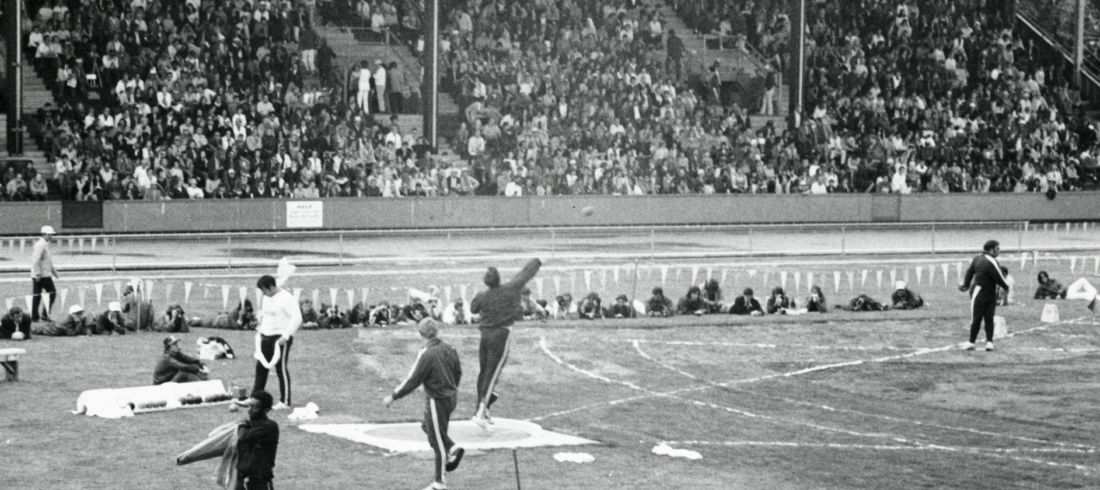By the early 1970s Hayward Field had hosted two NCAA track and field championships and a smattering of smaller events. The University of Oregon’s track and field program was going strong thanks to decades of leadership by Bill Bowerman. Steve Prefontaine, the best-known track athlete in the country, was bringing huge crowds to the stadium. It seemed like a fine time to go after one of the granddaddies of track and field events: The U.S. Olympic Team Trials.
The nonprofit Oregon Track Club led the process of asking the U.S. Olympic Committee (USOC) to grant Eugene the 1972 track and field trials. The city initially faced competition from Los Angeles and Seattle (which dropped out after being awarded another major track and field event in 1972). Rumor had it that Seattle threw its weight behind Eugene’s bid, The Register-Guard wrote in 1971, and Eugene ended up the victor.
Bill Rau was the OTC member who led the delegation to the USOC. When he heard the good news, he told The Register-Guard, “I think this confirms the belief that Eugene is the track and field capital of the nation.”
Fans crowded into Hayward Field to watch 10 days of stellar performances in 1972. Bob Seagren set a new world record for the pole vault, and Dave Wottle set a new record in the 800 meters. Steve Prefontaine beat his own American record in the 5,000 meters. Larry Young beat the previous American record for the 50-kilometer walk.
Sending the trials back to Eugene in 1976 was an easy decision for everyone involved. The USOC made an impressive $160,000 on the track and field trials in Eugene, The Register-Guard reported. A study conducted at the University of Oregon determined that visitors dumped between $600,000 and $800,000 into Eugene’s economy during the 1972 event.

In 1976, there was even more for spectators to see. The men’s and women’s trials were held together for the first time, which meant more events and more records. Madeline Manning Mims became the first American woman to run the 800 meters in under 2 minutes. Bruce Jenner came close to setting a new world record in the decathlon (and actually did break the record in Montreal later that summer).
Deciding where to hold the 1980 Olympic Track & Field Team Trials wasn’t so easy. A group from Durham, North Carolina, submitted a competitive proposal to host the trials at Duke University. The school’s Wallace Wade Stadium could seat 44,000 spectators, more than double the number that could fit into Hayward Field. And the North Carolina team drew attention to the fact that many athletes suffered from pollen allergies in Eugene.
The Eugene committee fought back hard, The Register-Guard reported. They promised to greatly expand the seating capacity at Hayward Field. They pulled medical records from the 1976 trials to show that only 10 percent of athletes complained about allergies. They argued that North Carolina would be too hot and humid at the time of the trials. After a long and emotional discussion, the committee voted 15-14 to give the trials to Eugene.
The trials’ trials weren’t over, however. In January, the U.S. announced it would boycott the 1980 Moscow Olympics to protest the USSR’s invasion of Afghanistan. The USOC decided to hold the track and field trials anyway. It would be a good experience for the athletes, they believed.
It was a real treat for fans as well, especially since they didn’t get to watch their favorite athletes at the Summer Games. Madeline Manning Mims became the first woman to win the 800-meter race four times in a row. Henry Marsh set a new American record for the steeplechase.
In 1984, the Olympic trials went to Los Angeles, which was hosting the Summer Games that year. It took until 2008 to bring the Olympic team trials back to Eugene. Now that the trials have been back three consecutive times, and Hayward Field has attracted worldwide events like the IAAF World Junior Championships in 2014, Eugene is reviving the argument that it’s still the track and field capital of the nation.


